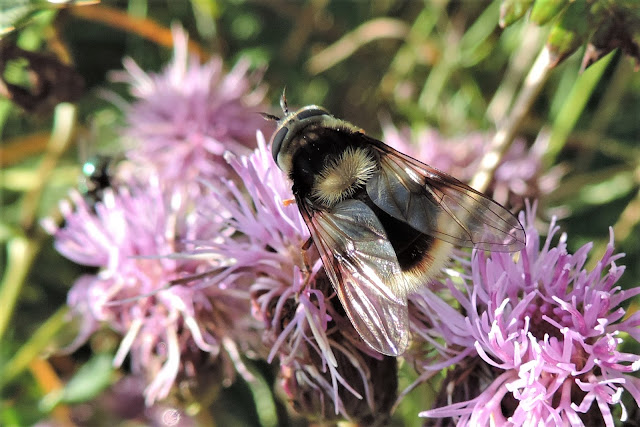Fine weather all weekend meant I could visit multiple sites totalling 49 species. Sites visited were Caerau (31), Gilfach (west) (27) and Garnwen (38). New for the year were Cheilosia longula (1) and Cheilosia scutellata (2), most numerous was Eristalis tenax (362). Good records included 4 Eupeodes species which were very numerous, Eristalis intricaria (3), Eristalis rupium (2), Dasysyrphus tricinctus (1), Didea fasciata (1) and Helophilus hybridus (1).
Monday, 30 August 2021
weekend hoverfly round-up
Wednesday, 25 August 2021
Devilsbit Scabious patch
A quick stroll to have a look at the Scabious patch at Newtown Bungalows stream revealed about 10% in flower, so about 7 to 10 days before its full potential is achieved. Nevertheless plenty of other flowers were in bloom and attracted 30 species of hoverfly, Eristalis tenax (25) being the most numerous. Other good records included Chrysotoxum Festivum (1), Eupeodes latifasciatus (3), Xanthogramma pedissequum (1) and Helophilus trivittatus (3).
Other flies included the tachinid Tachina fera and the conopid Physocephala rufipes. A nice surprise was a caterpillar of the moth Star-wort on Goldenrod, I've only seen a few adults. Small Copper was the best of the butterflies.
Chrysotoxum festivum
Saturday, 14 August 2021
Gilfach (west), Top Llangynwyd
A bout of fine weather at 1500 hrs had me travelling up to Top Llan to see what hoverflies were out after the rain. I wasn't disappointed with 37 species recorded. New species for the year are coming hard to get but Epistrophe grossulariae (1) was my 102nd for 2021. Most numerous species were Platycheirus albimanus (50) and Eristalis pertinax (50). A lot of the more local/scarcer species were seen and included Didea fasciata (1), Eriozona syrphoides (1 - my 7th of the year), Eupeodes lapponicus (1), Scaeva selenitica (2) and Helophilus hybridus (1).
Here's a selection of other insect species out today.
Thursday, 5 August 2021
Garnwen
Another fine day, temperatures reaching 20c+. Story of the day is my first ever Silver-washed Fritillary in the valley. It was seen flying about the tree tops up top Garnwen along the road to the big pond on the way to Afan Argoed. It really is a huge Fritillary and the colour, wing shape and pattern of this male is quite different to all other Fritillaries. On one occasion it came down to feed on Bramble blossom just in front of me for a moment and the silver washes could be seen when it closed its wings. But it was to quick too Photograph sadly.
On the hoverfly front a large count of 40 species were seen with Chrysotoxum arcuatum (1) finally new for the year. Most numerous were the Eristalis species particularly Eristalis pertinax (100+). Good records included Eupeodes lapponicus (3), Eriozona syrphoides (2) and Eristalis rupium (2).
Other insects of note were 3 Black Darter freshly emerged on the pond reeds along with 2 Keeled Skimmer and 2 Southern Hawker. Red Admiral butterfly was also present. Finally the first Stictoleptura rubra longhorn Beetle of the year was seen.
Wednesday, 4 August 2021
Maesteg cemetery area insects
Maesteg cemetery/school area
With the forecast for heavy cloud I thought today would be poor, but as usual the met office were way off and it turned out to be a fine warm (20c) day. Another day of hoverflies over 30+ species (35). With Paragus haemorrhus (2) and Chrysotoxum festivum (1) new for the year, taking me to 100 species for the year and is the seventh year on the trot I have achieved this feet. Most abundant species was Syritta pipiens (100) and good records included Eriozona syrphoides (1), Melangyna umbellatarum (1) and Riponnensia splendens (1).
Tuesday, 3 August 2021
Other insects last few days
Sunday/Monday hoverfly round up
Weather hasn't been brilliant but hoverflies are out in good numbers at the moment. I had 44 species over the 2 days at Lletty Brongu lanes (33) and Blaencaerau C.O.P. (38). New for the year and taking me to 98 for the year were Helophilus Hybridus (1) and Melangyna compositarum (1), the latter now being a single species rather than aggregate with the lumping of compositarum/labiatarum by European authorities and adopted by the British committee. Most numerous species was Syritta pipiens (351). Some interesting records include all 3 Leucozona, which doesn't happen very often, Melangyna umbellatarum (1), Sphegina elegans (1), Platycheirus rosarum (2), Scaeva selenitica (2) and Cheilosia vernalis (2).




















































